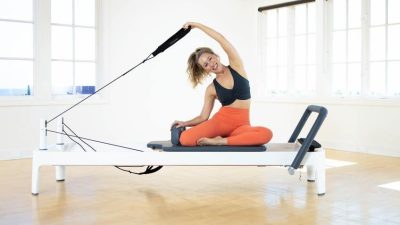
Lindy Royer is my mentor and friend. She helped me begin my Pilates journey years ago. Lindy was the one who inspired me to become an instructor and then took a chance on me by hiring me for my first instructor role in her studio.
As a seasoned Pilates instructor and physical therapist, Lindy brings a wealth of experience to this conversation. This is why she’s helping answer several questions from our members.
In this episode, we discuss the role of flexibility in our lives, the best exercises for the lower back, and how to age well. You won’t want to miss out on hearing directly from Lindy’s expertise. Press play to listen.
You will want to hear this episode if you are interested in…
- Improving flexibility [7:42]
- The best exercises for strengthening your lower back [27:48]
- The best exercises for sciatica pain [40:50]
- Improving tailbone and sacrum pain [49:04]
- How to feel well while aging [54:40]
- How to work with osteo issues [1:06:43]
Is being inflexible bad?
We use the word flexibility a lot and people often come to Pilates seeking more flexibility in their lives. But what does that even mean? Is being inflexible bad? How flexible should we actually be?
We often perceive stiffness because our brain is trying to protect us. If that is the case, more stretching won’t help. When this happens often what we are looking for is to feel more freedom of movement in our bodies. Lindy has a fantastic way to help the brain let go so that we can gain back that freedom of movement. Listen in to hear her tip.
The difference between flexibility and mobility
People often use Pilates to seek a specific, targeted goal. They are often wanting to increase the range of movement that their bodies can make to become more flexible.
There is a difference between flexibility and mobility. Mobility is flexibility with full control. To have full mobility you have to have body awareness, strength, and control. Passive flexibility isn’t helpful–it’s active movement that is important. You want to be able to control your joints in all directions for a full range of movement.
Science is finally coming to understand exercise more holistically
Science looked at exercise very differently even just 10 years ago. Doctors knew that exercise was important, but could only prescribe it in a narrow manner. Now we know that we need to incorporate the breath with whole-body movement to achieve whole-body health. One of the amazing things about Pilates is that it was light years ahead of its time. The mind-body connection has always been an integral part of Pilates.
Our sympathetic nervous system controls the fight or flight mode in our bodies. It puts us into survival mode, decreases flexibility, and makes us stiffer. When we are stuck in fight or flight mode we can’t access the creative thinking part of our brains.
Listen to this episode to hear why a strong back doesn’t necessarily remove pain, the best way to work through nerve pain, and how to use Pilates to age well. If you would like to hear more from Lindy you can check her out on our previous episode or look up her lessons in the Lindywell app.
Resources & People Mentioned
Follow Lindywell
Connect with Lindy
Join Lindywell
Subscribe to The Balanced Life






